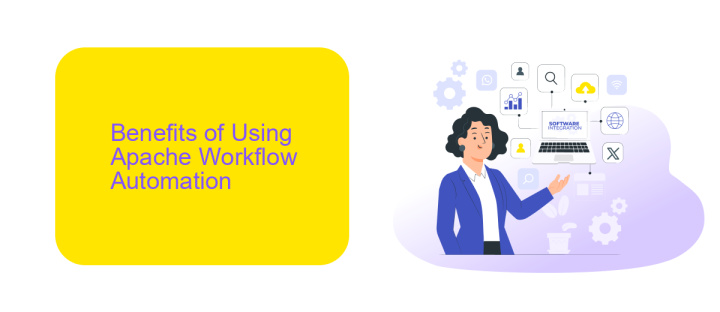Apache Workflow Automation
Apache Workflow Automation is a powerful open-source tool designed to streamline and optimize business processes. By leveraging the capabilities of Apache's robust infrastructure, it enables organizations to automate complex workflows, enhance productivity, and reduce operational costs. This article explores the key features, benefits, and practical applications of Apache Workflow Automation, providing insights on how it can transform your business operations.
Introduction: What is Apache Workflow Automation?
Apache Workflow Automation is a powerful open-source framework designed to streamline and automate complex business processes. By leveraging Apache's robust ecosystem, this tool enables organizations to create, manage, and monitor workflows with ease, ensuring efficiency and consistency in operations.
- Scalable and flexible architecture
- Support for diverse data sources
- Integration with various third-party services
- Real-time monitoring and analytics
One of the standout features of Apache Workflow Automation is its ability to integrate seamlessly with numerous external services, such as ApiX-Drive. ApiX-Drive facilitates the automation of data transfer between applications, enhancing the overall efficiency of workflows. By utilizing such integrations, businesses can ensure that their processes are not only automated but also optimized for performance and reliability.
Benefits of Using Apache Workflow Automation

Apache Workflow Automation offers significant benefits for businesses seeking to streamline their processes. One of the primary advantages is its ability to automate repetitive tasks, thereby reducing the likelihood of human error and freeing up valuable time for employees to focus on more strategic activities. This not only increases efficiency but also enhances overall productivity. Additionally, Apache Workflow Automation provides robust scalability, allowing organizations to handle increasing workloads without compromising performance or reliability.
Another key benefit is the seamless integration capabilities with various tools and services. For instance, using platforms like ApiX-Drive, businesses can effortlessly connect Apache Workflow Automation with their existing systems, ensuring smooth data flow and interoperability. This integration helps in creating a cohesive workflow environment where different applications work in harmony, leading to improved data accuracy and faster decision-making processes. Moreover, the flexibility of Apache Workflow Automation allows for easy customization to meet specific business needs, making it a versatile solution for companies of all sizes.
How to Install and Implement Apache Workflow Automation

To install and implement Apache Workflow Automation, start by ensuring your system meets the necessary prerequisites, including Java Development Kit (JDK) and Apache Maven. Download the latest version of Apache Workflow Automation from the official website.
- Install JDK and set the JAVA_HOME environment variable.
- Install Apache Maven and configure the MAVEN_HOME environment variable.
- Download Apache Workflow Automation from the official Apache website.
- Extract the downloaded files to your preferred directory.
- Navigate to the extracted directory and run the installation script.
- Configure the workflow settings in the configuration files as per your requirements.
- Start the Apache Workflow Automation service and verify the installation.
Once installed, you can integrate Apache Workflow Automation with various services to streamline your processes. For seamless integration, consider using ApiX-Drive, which allows you to connect different applications and automate data flow without any coding knowledge. ApiX-Drive supports a wide range of applications, making it an excellent choice for enhancing your workflow automation.
Best Practices for Workflow Automation

Implementing workflow automation with Apache requires careful planning and adherence to best practices to ensure efficiency and reliability. Begin by clearly defining your workflow objectives and requirements. This will help in selecting the appropriate tools and technologies for your specific needs.
Next, ensure that your workflows are modular and reusable. This approach simplifies maintenance and allows for easier updates and scalability. Use version control systems to manage changes and track the evolution of your workflows.
- Document your workflows thoroughly to facilitate understanding and troubleshooting.
- Leverage integration services like ApiX-Drive to connect disparate systems seamlessly.
- Regularly monitor and audit your workflows to identify and address any bottlenecks or issues.
- Implement robust error handling and logging mechanisms to ensure smooth operation.
Finally, continuously review and optimize your workflows to adapt to changing business requirements and technological advancements. By following these best practices, you can achieve a high level of automation efficiency with Apache, ensuring that your business processes run smoothly and effectively.
Case Studies and Examples of Workflow Automation in Practice
One compelling case study of workflow automation using Apache is from a global e-commerce company that streamlined its order processing system. By implementing Apache NiFi, the company was able to automate the data flow between its order management system and its warehouse management system. This reduced manual intervention by 70%, significantly speeding up the order fulfillment process and reducing errors. The integration allowed for real-time tracking and updates, improving customer satisfaction and operational efficiency.
Another example is a healthcare provider that utilized Apache Airflow to automate its data analytics pipeline. The provider needed to process large volumes of patient data to generate reports for clinical research. By automating the workflow, they reduced the time required to generate these reports from days to hours. Additionally, using ApiX-Drive, they seamlessly integrated various data sources, including electronic health records and laboratory information systems, into their Apache Airflow pipeline. This not only enhanced data accuracy but also allowed for real-time analytics, aiding in faster and more informed decision-making.


FAQ
What is Apache Workflow Automation?
How can I get started with Apache Workflow Automation?
What are the benefits of using Apache Workflow Automation?
How do I integrate different applications and services into my Apache workflows?
Is it possible to monitor and manage Apache workflows in real-time?
Time is the most valuable resource for business today. Almost half of it is wasted on routine tasks. Your employees are constantly forced to perform monotonous tasks that are difficult to classify as important and specialized. You can leave everything as it is by hiring additional employees, or you can automate most of the business processes using the ApiX-Drive online connector to get rid of unnecessary time and money expenses once and for all. The choice is yours!

